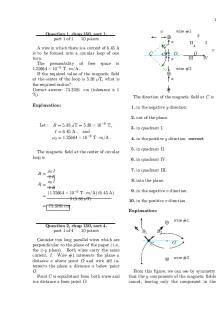Jackson 8 5 Homework Solution PDF

| Title | Jackson 8 5 Homework Solution |
|---|---|
| Author | Jesus De Hoyos |
| Course | Física moderna |
| Institution | Instituto Tecnológico y de Estudios Superiores de Monterrey |
| Pages | 2 |
| File Size | 124.2 KB |
| File Type | |
| Total Downloads | 86 |
| Total Views | 138 |
Summary
Lecture Notes...
Description
Jackson 8.5 Homework Problem Solution Dr. Christopher S. Baird University of Massachusetts Lowell
PROBLEM: (a) A waveguide is constructed so that the cross section of the guide forms a right triangle with sides of length a, a, √2a, as shown. The medium inside has μr = εr = 1. Assuming infinite conductivity for the walls, determine the possible modes of propagation and their cutoff frequencies.
a
SOLUTION: (a) If we tried to solve the waveguide outright, we would soon discover that the triangle geometry does not let us choose a natural coordinate system for the boundary conditions in which we can use separation of variables. Fortunately, this problem has enough symmetry that we can use a trick. The right triangle waveguide can be thought as a special case of the square waveguide with an extra boundary condition along the diagonal y = x. For TE modes, the square waveguide had solutions: B z =B0 cos
m x n y i k z −i t e cos where m and n = 0, 1, 2, … and a a
2
2= 2 m 2n 2 a
A quick calculation shows these already satisfy the boundary conditions on the bottom and right walls:
[ ] ∂ BZ ∂n
=0
S
The solution to the triangle waveguide can be a constructed as a superposition of the square waveguide solutions. But which ones? Whichever ones satisfy:
[ ] ] [ [ ] ∂ BZ ∂n
=0
y= x
1 ∂ BZ ∂ B Z − ∂y 2 ∂x ∂ BZ ∂ BZ = ∂x ∂y
y= x
=0 y= x
This can be satisfied automatically by constructing: B z = Bsqz x , y B zsq y , x
[ ]
B z =B0 cos
m x n y n x m y cos cos cos a a a a
e i k z −i t
where m ≥ n ≥ 0 must hold but m = n = 0 is not allowed. For TM modes, the solution to the square waveguide is: E z=E 0 sin
2 2 2 2 m x n y i k z−i t e sin where m and n = 1, 2, … and = 2 m n a a a
A quick calculation shows these already satisfy the boundary conditions on the bottom and right walls:
[ E z]S =0 The solution to the triangle waveguide can be a constructed as a superposition of the square waveguide solutions. We must satisfy:
[ E z]x= y =0 It should be obvious that this is automatically satisfied if we construct: sq E z=E sq z x , y− E z y , x
because when x = y, the two terms become identical and their sum vanishes.
[ ]
E z=E 0 sin
m x n y n x m y sin −sin sin a a a a
e i k z−i t where m > n > 0
The cutoff frequencies are the same as for the square waveguide: mn=
c m2 n 2 a...
Similar Free PDFs

Jackson 8 5 Homework Solution
- 2 Pages

Jackson 7 22 Homework Solution
- 4 Pages

Homework Solution 8
- 3 Pages

5 - online homework solution
- 8 Pages

Homework Solution 5
- 3 Pages

Chapter 5 Homework solution
- 16 Pages

90143263 Solution Jackson Chapter 1
- 44 Pages

Homework Solution
- 49 Pages

Ee 209 5 homework and solution
- 6 Pages

Homework 8
- 3 Pages

Chapter 7 solution - homework
- 8 Pages

Homework Solution 11
- 4 Pages

Homework Solution 10
- 4 Pages

Homework 5
- 2 Pages

Homework 5
- 9 Pages

Homework 1 Solution
- 15 Pages
Popular Institutions
- Tinajero National High School - Annex
- Politeknik Caltex Riau
- Yokohama City University
- SGT University
- University of Al-Qadisiyah
- Divine Word College of Vigan
- Techniek College Rotterdam
- Universidade de Santiago
- Universiti Teknologi MARA Cawangan Johor Kampus Pasir Gudang
- Poltekkes Kemenkes Yogyakarta
- Baguio City National High School
- Colegio san marcos
- preparatoria uno
- Centro de Bachillerato Tecnológico Industrial y de Servicios No. 107
- Dalian Maritime University
- Quang Trung Secondary School
- Colegio Tecnológico en Informática
- Corporación Regional de Educación Superior
- Grupo CEDVA
- Dar Al Uloom University
- Centro de Estudios Preuniversitarios de la Universidad Nacional de Ingeniería
- 上智大学
- Aakash International School, Nuna Majara
- San Felipe Neri Catholic School
- Kang Chiao International School - New Taipei City
- Misamis Occidental National High School
- Institución Educativa Escuela Normal Juan Ladrilleros
- Kolehiyo ng Pantukan
- Batanes State College
- Instituto Continental
- Sekolah Menengah Kejuruan Kesehatan Kaltara (Tarakan)
- Colegio de La Inmaculada Concepcion - Cebu